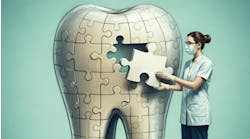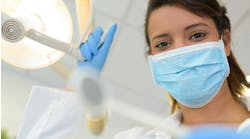Digital photography: Your modern communication and marketing tool
by Michael Morris, CDT
Accredited Fellow Member, AACD
For more on this topic, go to www.dentaleconomics.com and search using the following key words: digital photography, AACD, accreditation, focus, magnification, Michael Morris.
Dentistry, more than any other area of health care, has benefited from trends and advances in digital photography, and a well-developed protocol for dental photography can be an enormous enhancement to the practice of dentistry.
The American Academy of Cosmetic Dentistry has led the way in establishing standards for dental photography, requiring accreditation candidates to present cases with specific and precise photographic documentation. Because these protocols have been rigorously tested and refined, they provide an excellent guide for dentists and laboratory technicians who wish to use photography more effectively.
The use of cameras in dentistry has added considerably to clinical knowledge and protocols. Moreover, capturing patient images allows clinicians to share information with referring doctors and lab technicians, as well as present their quality of work when marketing their practices.
For many reasons, trying to operate a dental practice or laboratory at a high level without a camera is like trying to work with one hand tied behind your back.
“The camera is an indispensable tool in my practice,” said Dr. Fred Arnold, of Lexington, Ky. “With a heavy emphasis on esthetics and smile design, photography plays a crucial role in diagnosis and treatment planning, as well as laboratory communications and evaluation of various treatment steps. Posttreatment photography is also important for a critical evaluation of the treatment results and for educational uses.”
Consider the aspects of your practice in which photography can be used to great advantage:
- Digital photography is a great problem-solving tool for the technician and clinician because, when accurate, little or no additional written or spoken dialogue is required. Individually, each passes along necessary information.
- Proper composition assists in accurate study and appraisal and makes it possible to anticipate and manage mid- and posttreatment complications prior to the completion of dental care.
- Viewing intraoral and portrait shots in still-life form generates the diagnostic protocol considerations for color, soft tissue, tooth form, and alignment.
- Previsualization of the final treatment allows for the use of prototype temporaries for verification of basic design of color, form, and function.
- Once the clinical treatment confirmation phase begins, constant adjustments from pictoral evaluation between dentists and technicians aids in case completion because digital information can be transferred so easily.
- Visually aided patient consultations can significantly increase productivity of the practice.
- Successful cases can be artfully exhibited, as office décor in the practice or on dental and lab Web sites.
- The sight of a professional camera in the operatory gives patients confidence. Recording patients photographically to archive existing conditions or generate diagnostic records is a new experience which, for many patients, generates respect for a dentist's expertise and an elevated level of service from the practice.
Good composition and focus are the elements that drive the story told by pictures and which influence the emotional responses of the viewer. Images are the vehicles that capture emotion that helps patients make decisions. The feeling of confidence and positive treatment, captured in digital depiction, becomes the visual testimony that wins cases in the court of treatment acceptance.
“I've been using photography since 1996 in my new-patient exams,” said Dr. Marilyn Gaylor, of Atlanta, Ga. “Since then, I have used it for all consultations. Previously, I showed slides on a projector and now I use my laptop. I use it as a diagnostic tool to evaluate esthetics, function, and health. Photography helps the patients to understand the condition of their teeth. We have now incorporated six photos into our hygiene checks once a year. We give the photos to patients when they leave. Because of this, they are accepting more treatment. We also use it for shade selection in crown-and-bridge procedures. We now take more photos than X-rays. I also use it for communication with specialists and laboratory technicians.”
Dental teams can derive a significant portion of their fulfillment from a sense of service and accomplishment. Patient photography allows them to revisit their results and take pride in their work. This is especially true for laboratory technicians, who generally do not have the opportunity to view patients directly. The impact of showing technicians pre- and posttreatment images can go a long way toward making them feel included and important to the results.
The creative circle is closed when the designer and builder have an opportunity to collaborate and see their project through each step to completion. The same is true for the acceptance and power of digital workflow communication between dentists and laboratories. The feedback received through the study of posttreatment photography by the dental team is motivating. Faults clearly can be defined, and can become stepping stones to continuous improvement.
Another plus for dental teams is reduced stress in patient treatment. Current systems of diagnostic protocols are verified using macro photography. Advanced camera and flash systems allow photographic duties to be delegated. Because little training is required, these skills can be transmitted quickly and easily. This adds to the productivity of treatment produced using photographic systems.
The basis of AACD photography is to produce documentation that is true to life in a pure medical photographic style. The standard established by the AACD consists of 12 patient views both before and after treatment.
For consistency, views are fixed magnifications of varying life-size ratios. Because many digital camera sensors do not correspond to 35-mm film frame proportions — from which life-size ratios were derived — users must know their specific lens settings for the magnification required to achieve the conversion to meet the AACD's explicit standard of calibration.
The first view is the frontal portrait smile at 1:10 magnification, followed by 1:2 frontal, right and left lateral smile, 1:2 frontal, right and left retracted view with teeth slightly separated, 1:1 retracted frontal, right and left of maxillary arch, 1:2 occlusal view of maxillary, and mandibular arches obtained with the aid of mirrors. This arrangement allows complete cosmetic evaluation.
Smile shots assist in determining macro elements of smile design: midline, tooth, and tissue display, buccal corridor, smile-line, and incisal embrasure form.
Retracted views display the micro category of design: central dominance, proportion, harmony and symmetry, axial inclinations, emergence profile, detail of individual tooth form and color, tissue health, and architecture. Arch form, tooth facial lobe development, line-angle, and facial embrasures are observed with occlusal images. Additional essential photography of prototype temporaries and shades that show tab information complete lab case materials.
Michael T. Morris, CDT, is a 1991 graduate of the Dental Laboratory Program at Lexington (Ky.) Community College. He is an Accredited Fellow and chairperson for Laboratory Accreditation in the American Academy of Cosmetic Dentistry. Morris is a world member of Claude Sieber's Art and Experience Group. His e-mail address is [email protected].
Frequently Asked Questions
Question: Can I use any digital camera for dental photography?
Answer: No. A purpose-specific macro lens and flash are necessary for good close-up and retracted dental photography. Therefore, only a digital SLR (single-lens reflex) that allows for attaching a 100-mm to 105-mm macro lens and ring or other macro-specified flash will work.
Question: I'm familiar with taking pictures with a point-and-shoot digital camera, using the back LCD screen. Can I shoot the same way with a pro DSLR?
Answer: It is generally considered that the best technique for dental macro photography with a DSLR is to view and frame images while looking through the eye-piece viewfinder. Newer cameras offer the ability to shoot with the LCD screen in live-view mode. Most people find using the LCD screen to be difficult in focusing for close magnification, as well as for navigating menus and control buttons necessary to switch to live-view mode as compared to using the eyepiece.
Question: How important are megapixels?
Answer: A 6-megapixel minimum is sufficient for dentistry purposes; however, most new cameras will have a minimum of 10 and as many as 21 megapixels. The importance of high megapixel count is significant to pros and enthusiasts who want the highest print quality in large sizes, such as 16x20 and larger. Six to 10 megapixels will serve an office well for digital communication, viewing, and modest print-making.
Question: What should I buy, and what should I expect to pay?
Answer: A popular brand of beginning-end “pro” camera with 10 megapixel range will have a rugged build, high-tech look, and give many years of service (entry- level plastic body digital SLRs will be less costly and lighter to hold). Beginning level “pro” bodies will range from $900 to $2,000; 100-mm and 105-mm macro lens will be $500 to $800; a ring or dualpoint flash for macro photography will be $500 to $650. Popular brands include Canon, Nikon, Fuji, Olympus, Sony, Pentax, and Sigma.
Question: How can I save money on a camera purchase?
Answer: Because photographers want more from a camera than is necessary for dentistry, the greatest savings are found on used digital SLR bodies. The Internet offers many reputable resellers. Although there are off-brand lenses and flashes available at slightly reduced prices, it is most advisable to choose a same-brand body, lens, and flash system. Do your homework to make certain a purchase will be a working combination if you choose to mix aftermarket brands of equipment.
Since the advancement for the standard in dental documentation and photographic evaluation was created in the AACD, dentistry and the public now have higher expectations. The benefit of investment return and short-term learning curve make dental photography a must in today's treatment arena.





